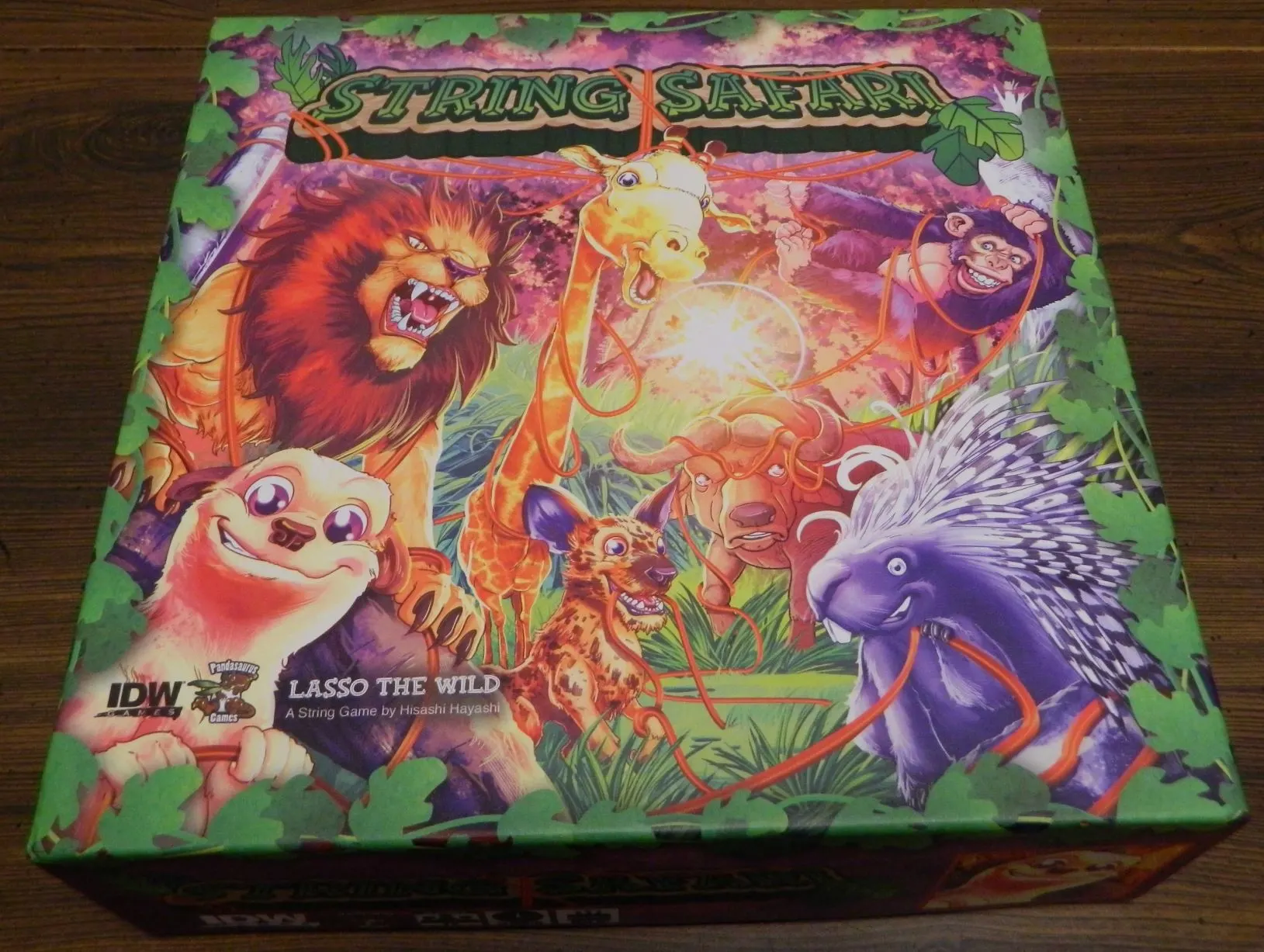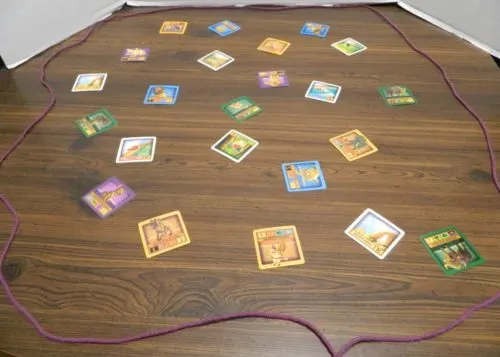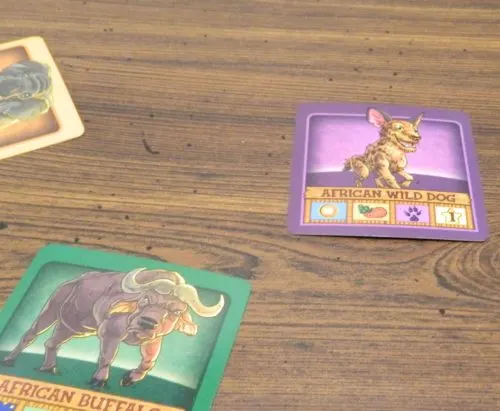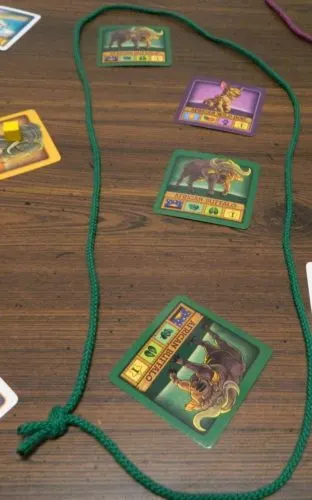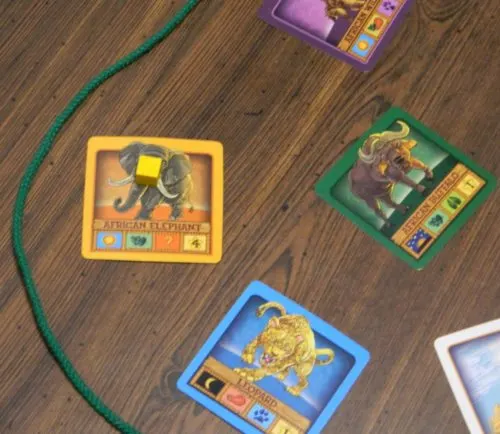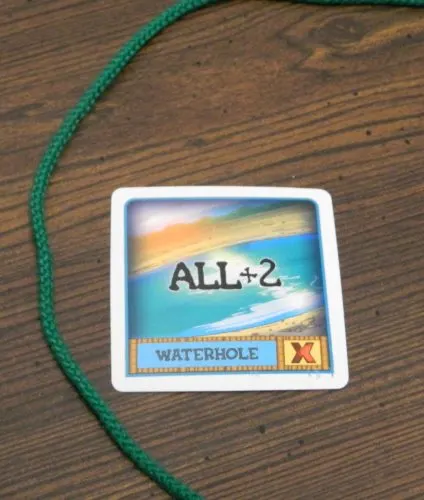Having played so many different board games I have seen a lot of different board game components. Most games use the same type of components, but there is the occasional board game that actually tries to do something original. As a fan of games that try to do something original I always appreciate when a board game tries to do something new with its components. This can be a double edged sword though. Unique components can lead to truly revolutionary board games, but they can just as easily lead to disaster as the designer is more worried about using the components than actually making an engaging board game. Despite playing so many different board games I have to say that I have never played a game that has used a string as a major component. It might not seem like an obvious board game component at first glance but when you start to think about there is a lot of potential. Most known for Yokohama and Trains, designer Hisashi Hayashi’s first game was a game called String Railway which was one of the first games to use a string as a major component. A few years later Hisashi Hayashi created the game that I am looking at today. String Safari is a truly original game experience filled with some really interesting ideas that the whole family can enjoy.
How to Play String Safari
Setup
- Each player chooses a color and takes research markers of that color. The number of markers they take will depend on the number of players:
- 3 players – 6 markers
- 4 players – 5 markers
- 5 players – 4 markers
- Each player takes one of the other markers of their color and places it on the one space of the victory points track.
- Spread out the field string (purple) on the table. The string should not pass over itself. The game recommends that you make it a large circle for your first game, but you can make it into any shape. The area inside the string will be called “the field”.
- Shuffle the land tiles and randomly place them out into the field face up.
- Shuffle the animal tiles and randomly place 16 of them face up inside the field. The rest of the animal tiles will form a draw pile. None of the animal tiles or land tiles can touch one another. All tiles must be at least the width of one finger away from the field string.
- Shuffle the research tiles and line up five of them face up outside the field string. The rest of the research tiles form a draw pile.
- The player who was most recently in Africa will start the game. If none of the players have been to Africa the player who has most recently been to a zoo will start the game.
Preparation Round
String Safari is played over a number of rounds. The game will begin with a preparation round. There will then be a number of rounds based on the number of research markers the players took at the beginning of the game.
For the preparation round the players will take turns starting with the first player and then moving clockwise. Each player will first draw the top animal card from the draw pile and keeps it in their hand. Each player will then choose a research tile for the first round. The players can either take one of the face up research tiles or the top face down card from the draw pile. If a player takes one of the face up cards it will be replaced with the top card from the draw pile. You will place your chosen tile face up in front of you.
Playing A Round
For each round in the game each player will get one turn. Play will then pass clockwise to the next player. Each player’s turn consists of eight steps. You will take all eight steps during your turn except for your turn during the final round where you will skip steps 6-7. The steps each player will follow on their turn are as follows:
Step #1: For the first step you will take the animal tile you took during the last round and place it face up inside the field string. When placing the animal tile it cannot touch any of the other tiles or the field string. Each tile should be placed at least one finger’s width away from any other tile.
Step #2: The second step involves placing the research string inside the field string to enclose animals. When placing the research string it may not touch any tiles and it may not lie on top of itself. You do not have to enclose the animal tile that you just placed inside the research string. For more information about placing the research string and scoring see the Researching section below.
Step #3: You will score points based on where you placed the research string. Move your marker forward along the scoring track based on the number of points that you scored. If you score over 50 total points take one of the 50 point tokens and move your scoring token back to the start of the scoring track. See the Researching section below for more details.
Step #4: Choose one of the tiles inside the research string to place one of your research markers on. You may not place the marker on a tile that already has a marker. You also can’t put a marker on a land tile except for the Footprints tile. Your research marker will stay on the tile for the rest of the game. Placing the research marker on a tile will prevent the other players from using that tile to score points for the rest of the game. You will also score points for your chosen tiles at the end of the game.
Step #5: Remove the research string from the table.
Step #6: Draw a new animal tile from the top of the draw pile. You will keep this tile in your hand until your next turn.
Step #7: Choose a research tile for your next turn. You can either take one of the face up tiles or the top face down card from the draw deck. The card you choose will be placed on top of the research tile you used this round.

The current player can either choose one of the five face up tiles or the top tile from the draw pile.
Step #8: Pass the research string to the player on your left.
Researching
Before placing the research string you need to look at the bottom right corner of your research tile. There may be one of two symbols in this corner which will impact where you can place the research string.
If there is a symbol featuring two squares you must place the research string so it touches the field string.

This player has chosen a research tile that requires them to have their research string touch the field string.
If there is a symbol featuring a rocky feature you must enclose one of the rocky area tiles inside the research string.
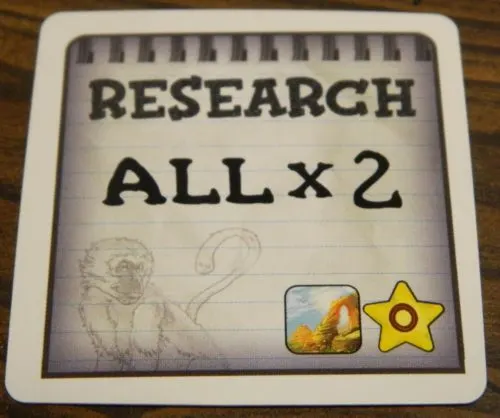
For this research tile the player will have to enclose a rocky area tile due to the symbol in the bottom right corner.
Otherwise when placing the research string there are a couple things that you should consider as there are a couple different ways to score points. When figuring out which tiles you would like to enclose you must note that any tiles that feature research markers from the other players cannot be used to score points. Tiles that have your own research token though can score you points.
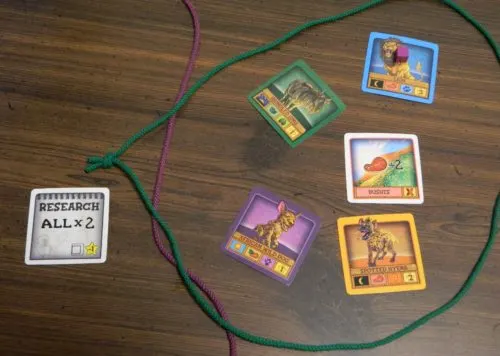
If the current player is not the purple player they will not be able to use the lion card with the purple research marker on it when determining their score.
The main way to score points is to complete the objectives on your current research tile. There are a couple different types of research tiles which score points in different ways.
Most of the tiles will feature a symbol with a number next to them. The symbol indicates the types of animals that you will be rewarded for placing inside the research string. Each animal tile features various symbols which include when the animal is active, what type of food they eat, and what animal family that they are part of. The number to the left of the symbol indicates the amount of points that you will score for each animal inside the research string that matches the symbol.
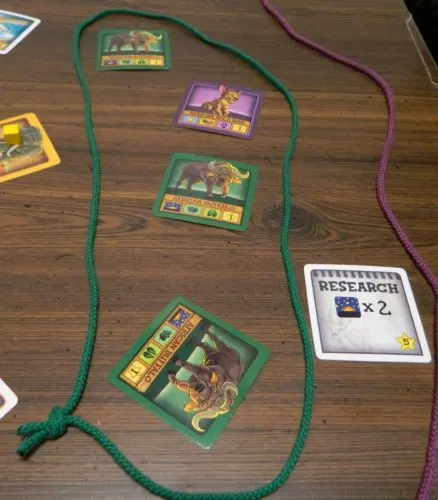
For this player’s research tile they will score two points for each tile that has the evening symbol. This player has roped in three animal tiles that feature the symbol. They will score six points for the research tile.
Research tiles that say All and then a number will score the number of points on the right for each animal inside the research string.
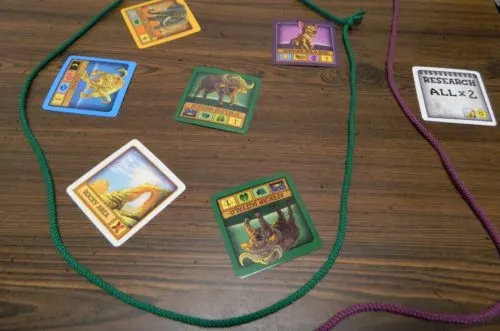
This player has an “All” research tile so they will score two points for each animal tile they enclosed with the research string. As there are five animals inside the research string they will score ten points from the research tile.
Finally there are research tiles that feature the symbols of all of the different animal families. For these research tiles you will score the number of points shown on the research tile for each unique animal family type that is inside the research string.
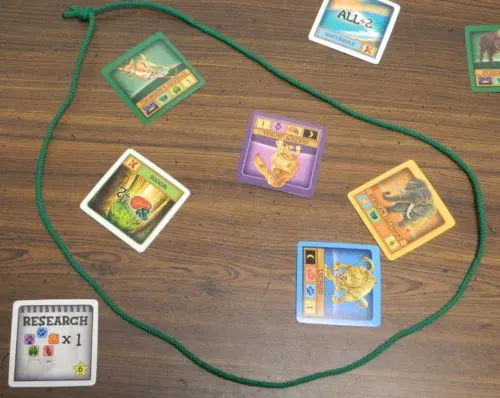
Due to their research tile this player will score one point for each different colored animal tile that is enclosed inside the research string. As there are four different colored animals enclosed in the research string they will score four points.
The other way to score points involves the land tiles.
Three of the tiles feature one of the types of food. If you enclose the land tile and at least one animal that eats that type of food you will score two bonus points.
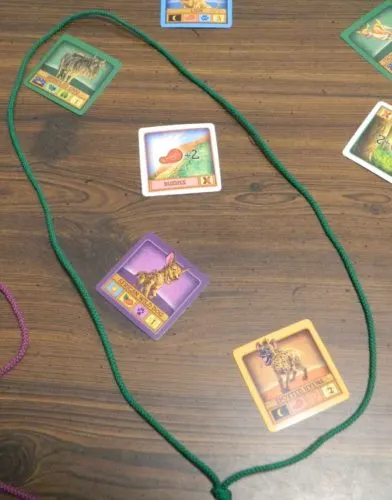
This player has enclosed the bushes land tile. This tile adds two bonus points if you enclose an animal that only eats meat. As this player has enclosed an animal that only eats meat they will score two bonus points.
If you enclose the Water Hole inside the research string you will receive two bonus points.
Finally if you enclose the Footprints tile you will score one bonus point. If you place your research marker on this tile you will draw two animal tiles at the end of your turn. You must place both of these tiles on your next turn.
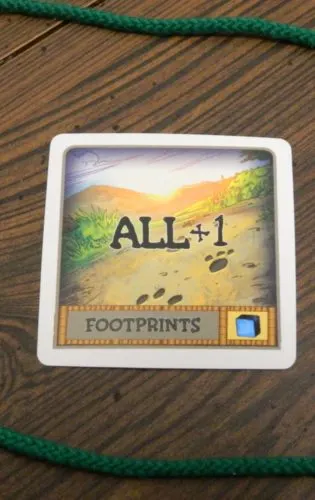
This player has enclosed the Footprints tile. They will score one bonus point. If they put a research marker on this tile they will get to draw two animal tiles to play on their next turn.
End of Game
The game ends when each player has taken their turn in the final round. Players will then conduct final scoring.
Players will gather up the tiles that they placed a research token on. In the bottom right corner of all of these cards is a number inside a star. You will score the corresponding number of points for each tile you claimed.

During the game this player has played research markers on these five animal tiles. The player will score points for the tiles based on the number in the bottom right corner. This player will score ten points from the tiles (3 + 3 + 1 + 2 +1)
Then you will look through the research tiles you took during the game. You will score points equal to the number in the bottom right corner for each research tile.

A player took these research tiles throughout the game. They will score points for them based on the number in the bottom right corner. They will score fourteen points for these tiles (5 + 6 + 1 + 3 – 1).
Players will then compare their final scores. The player who scores the most points will win the game. If there is a tie the player furthest away from the starting player will win the game.
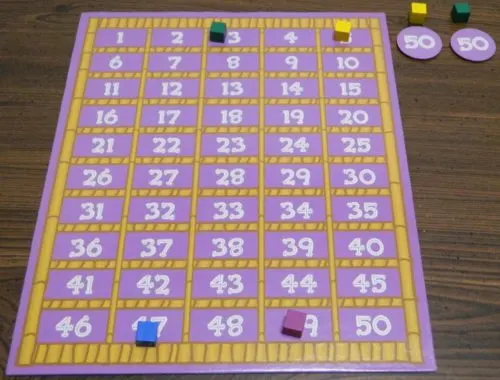
The yellow player has scored 55 points which is more than the other players. The yellow player has won the game.
My Thoughts on String Safari
While it was obvious that a game called String Safari would utilize a string as a major component, I was curious what it would be like playing a board game focused around using a string. Basically animals are placed around the table. Player must use the string in order to rope in animals so they can study them to score points. You score points based on your chosen research goal for the turn and any special land tiles that you enclose. This could involve roping in as many animals as possible or roping in animals that share some characteristic in common. The player that is best at roping in animals that are worth the most points will win the game.
After a quick glance at the game most people will probably think that String Safari looks like a children’s or family game. From the colorful box to the emphasis on animals I can definitely see people coming to that conclusion. In some ways it is accurate but in other ways it isn’t. The game is more complicated than your typical children’s game as it does have a recommended age of 10+. As it plays quite a bit differently than your typical board game it does take a little longer to explain than a lot of games. It will probably take five to ten minutes to explain the game to most new players. This leads to the game having a little longer learning curve than other similar games. The game’s mechanics are still pretty straightforward though. The players may need a turn or two to adjust to the mechanics, but they should have no troubles after that point. As a matter of fact I think the age recommendation is a little high as I think children younger than ten shouldn’t have too many troubles with the game.
The simplicity may make you think the game is mostly for children but I see it as more of a game for families and people who like light to moderate strategy games. This is because there is more strategy to the game than you would first think. There is some luck to the game (which I will get to later), but you have a lot of control over your own fate in the game. You have important decisions to make and they will have a significant impact on how well you do in the game.
The first significant decision that you have to make in the game involves which research tiles you decide to take. For this decision you can either take one of the face up tiles or the top tile from the draw pile. There are a couple things you have to consider before you choose which one to take for your next round. The first thing you will probably consider is what tile gives you the most opportunities to score points in the next round. The research tiles mostly break down into three groups. You usually either have to round up the most total animals, the most animals of different colors, or animals that meet a certain criteria. After studying the face up research tiles you need to look over the field for an area that can score a lot of points based on the available research tiles. You also have to consider how much the tile itself will be worth at the end of the game. Some tiles may score you more points during the round, but may not be worth many points themselves at the end of the game. You need to find a research tile that will score you the most points between the current round and the end of the game. Putting all of this together you need to pick one of the face up research tiles or take a chance with a random face down tile.
After you have chosen your research tile the main decision in the game will be to determine where you want to place the research string. This is the key decision in the game as it will determine how many points you score in the game. When you choose your research tile you likely came up with an ideal position to place the research string in order to score the most points. As all of the other players have had a chance to take their turn though things could have changed drastically since your last turn. You also have more to consider than just your research tile. First you need to consider where you are going to place the animal tile in your hand. If it will help you score more points you should try to place it in an area near as many other tiles that you could use for your research tile. You also need to consider the land tiles located around the play area. These won’t score you as many points as your research tile, but they will add a few points here or there which could be the difference between winning and losing the game.
When choosing where to place the string you need to be creative. You may first think of just creating a large circle to enclose as many animals as possible. In some situations you may be better off making a more winding loop with thinner and thicker areas. This may give you enough slack where you can enclose two animals together that you otherwise wouldn’t be able to. The game has a strict rule where the string can’t touch tiles. We ended up playing with more lenient rules though where if you had enough leftover slack to bend the string away from tiles you were allowed to place the string even if it technically touched tiles. We used this rule because with enough slack you should eventually be able to bend the string in a way where it wouldn’t touch the tiles. This could take quite a while though and stubborn players may be willing to take the time to make sure they maximize their score. We thought it was better to be a little more lenient with this rule in order to save some time.
The final important decision that you have to make is deciding which tile you want to place your research marker on. I personally see two different ways of approaching this decision. The first option is to place it on the animal tile that is worth the most points. If a tile is only worth one or two more points this might not be that big of a deal. Some tiles can be worth three or more points than the neighboring tiles. It is hard to pass up these extra points. The other option is to choose a tile that is in a strategic position. For example if there is an animal that requires a certain type of food and it is positioned near the same land tile it might be good to claim this tile as it allows you to score the bonus each time you enclose the animal and land tile. This also denies the other players the same opportunity. You could also choose to use your research markers to mess with the other player’s strategies. As you can always see what research tiles the other players will use on their next turn you may choose to claim a tile that another player is likely to use to prevent them from scoring as many points. This adds a little mechanic where it is possible to mess with one of your opponents.
String Safari will never be confused for a highly strategic game, but it deserves credit for doing a good job balancing between simplicity and strategy. The game is simple enough that families should have no problems playing it. At the same time though there is enough strategy to keep older children and adults entertained. String Safari may not be for people that like games that require a lot of strategy, but I really enjoyed my time with the game. I have played a lot of different board games and yet I have never played anything quite like String Safari. The game is truly innovative and deserves a lot of credit for that fact. I could see families and people who like board games that are light-moderate on the strategy scale should really enjoy the game.
There are a lot of things to like about String Safari. I had two issues with the game though.
First the game relies on quite a bit of luck. Your decisions will have a big impact on how well you do in the game. No matter how good your decisions are though you won’t be able to overcome luck not being on your side. Most of the luck in the game depends on the tiles you draw. Some animal tiles are worth considerably more points than others. As the player who draws these tiles gets the first opportunity to claim them with their research marker they can score quite a few free points just by drawing more valuable animal tiles than the other players. The groups that an animal tile belongs to can also play a big role in how many points you can score in a round. If the animal tile in your hand works well with one of the face up research tiles it can be used to score you more points.
This is the other area where luck can play a big role. The research tiles that you have available to you will determine how many points you can score on your turn. If a perfect tile is available you will obviously take it as it will score you a lot of points. If the available options aren’t very good though or they don’t work with the animal tile in your hand, you may have to consider drawing the random face down tile. You could draw a really good tile or be stuck with one that will score you few points. Players who are more creative with the string can overcome some of this luck, but a player that gets more advantageous research tiles is going to have a pretty big advantage in the game.
The other issue I have with the game comes from the components. For the most part the components are solid. The two strings are pretty thick and durable. The artwork had some mixed opinions in our group even though I thought it was pretty good. The tiles are designed well where you can easily find any necessary information. The game also mostly relies on symbols instead of words making it language independent. The problem with the tiles is that they feel too thin. I would say that the tiles are around the thickness of a typical card. The problem with the tiles being so thin is that it is hard to not accidentally move them around while playing the game. Whether you touch them with the string or your fingers the tiles will move slightly. Even breathing on them hard could move them. Throughout the game the tiles will move even if you try your hardest to keep them in place. As the position of the tiles is key to the gameplay this will impact the game. To prevent this I think String Safari should have made the tiles a little thicker.
Should You Buy String Safari?
I have played a lot of different types of board games and yet I have never played one quite like String Safari. Basically the game takes the mechanic of laying a string around tiles and makes a whole game out of it. This might not sound like much but it does a good job creating a satisfying experience. String Safari may take a little longer to learn than some other family games, but once you get a hand of it it is quite easy to play. There is a decent amount of strategy to the game as well. Which tiles you choose and where you place your research string will have a big impact on how well you do in the game. This balance between simplicity and strategy means that the game is simple enough for children and yet interesting enough to keep adults engaged. The game does rely on quite a bit of luck though and the tiles could have been thicker which would have prevented them from sliding around so much.
People who think the premise of the game doesn’t sound all that interesting or like heavy strategy games probably won’t like the game. People who like original games or like lighter games that the whole family can enjoy though should really enjoy their time with String Safari. For those people I would recommend picking up String Safari.

